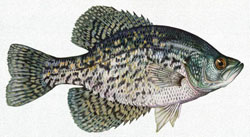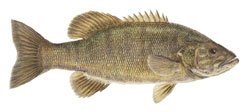 About
About
The Bluegill (Lepomis macrochirus) is a species of freshwater fish sometimes referred to as bream, brim, or copper nose. It is a member of the sunfish family. It is commonly fished in Minnesota, Michigan, Wisconsin, Texas, and Louisiana, and is the state fish of the U.S. state of Illinois. It is renowned as an excellent tasting fish on par with Walleye.
Of tropical sunfish body shape, the bluegill's most notable feature is the blue or black "ear", actually an extension of the gill cover called the opercular flap. Its name, however, comes from the bright blue edging visible on its gill rakers. The bluegill grows to a maximum overall length of approximately 16 inches.
Bluegills are excellent fish to teach children angling. They are notorious for their nibbling or pecking style of feeding and commonly steal bait off a fisherman's hook.
Fishing Techniques
Best Bait to Use
Waxworms are by far the most popular Bluegill bait, Spikes, Eurolarvae or maggots can be another option.Where to Look for Them
Look for active bluegills under or near docks, weed edges or lily pads, don't overlook shorelines where shaded areas are used by these easily spooked fish. About
AboutPomoxis is a genus of freshwater fish in the sunfish family (family Centrarchidae) of order Perciformes. The type species is annularis, the white crappie. The common name crappie refers to either of the Pomoxis species, both of which are extremely popular game fish.
The Pomoxis species are highly regarded game fishes and are often considered to be among the best tasting freshwater fish. Because of their diverse diets, crappie may be caught in many ways, including casting light jigs, trolling with minnows or artificial lures, using small spinnerbaits, or using bobbers. Crappie are also popular with ice-fishers, as they are active in winter.
The maximum recorded length for a crappie is 21 inches, with a maximum weight of almost 5.18 lb it can live as long as ten years.
Fishing Techniques
Catching Crappies on a regular basis can be easy at times or very difficult when they are not feeding. A popular open water method is to bobber fish with a small fixed or slip bobber, 1 to 2 feet off bottom is a good place to start until the fish are aggressive and start suspending in the water column. A small jig and tiny Crappie minnow or waxworm is the preffered bait, you can fish for them under a bobber or without, casting and retrieving is another great method to locate a school of crappies. Both methods are done with the same tackle and baits.
Best Bait to Use
Small Crappie minnows or waxworms are the most popular baits. Spikes, Eurolarva and waxies are generally better in the winter months.
Where to Look for Them
Look to shallow water in the spring and fall, 2-5 foot of water is very common during these periods, try 5-30 feet in the warmer months and the same in winter. Crappies will generally be in deeper structured waters during the winter or the warmer times of the year. Fishing for Crappies in weeds, cattails, brush or lily pads is a great place to start. Crappies prefer structure like logs, trees or weeds, so they can hide from predator fish.
 About
AboutThe smallmouth bass (Micropterus dolomieu) is a species of freshwater fish in the sunfish family (Centrarchidae) of order Perciformes. One of the black basses, it is a popular gamefish sought by anglers throughout the temperate zones of North America, and has been spread by stock to many cool-water rivers and lakes in the United States and Canada. The smallmouth bass is native to the upper and middle Mississippi River basin.
The smallmouth bass is generally green with dark vertical bands rather than a horizontal band along the side. There are 13-15 soft rays in the dorsal fin. The upper jaw of smallmouth bass does not extend beyond the back of the eye.
The smallmouth bass is found in clearer water than the largemouth, especially streams, rivers, and the rocky areas and stumps and also sandy bottoms of lakes and reservoirs. The smallmouth prefers cooler water temperatures than its cousin the largemouth bass, and may be found in both still and moving water. Because it is relatively intolerant of pollution, the smallmouth bass is a good natural indicator of a healthy environment, though it can better adjust to changes in water condition than most trout species.
Fishing Techniques
Best Bait to Use
Live bait rigs should never be overlooked: Slip bobbers, Carolina rigs, Lindy rig, jigs or plain hook and split shot rig.
Best live baits: would be night crawlers, leeches and minnows.
Various methods of boat presentation:
Anchored: while fan casting, slip bobbin, or just straight down over the side 1 ft off the bottom.
Drifting: split shot and hook.
Back trolling (very slow) Lindy rig or Carolina rig.
Where to Look for Them
Depending on the clarity of water, boat traffic, and time of year, these conditions will dictate the whereabouts of the big smallmouth. Very early Spring (pre spawn) you will spot the bass cruising the shallows especially on sunny days. That's the only time that the sun is our friend since the bass love to sun themselves during pre spawn with the water being so cold. The sun penetrates the water and is absorbed by the dark color of the fishes back. Just as if you wear a black coat out on a cool sunny day, you will warm up faster as the black absorbs the suns rays. Unfortunately early spring bass are also very skittish and spook easily.
Try to stay off those spooky fish by making long casts. You may want to try positioning your boat in open water around 20 ft while casting towards the shore side. Work top water baits, suspending Husky Jerks and 3/4 oz football jigs with plastics. This way you will cover 3 different levels of the water column and you will find what's working. Bass will come up from 20 ft depths to smash a top water or suspended Husky Jerk at that time of the year. Work the baits slowly as you move the boat along with a lot of stop and go.
Smallmouth generally begin to spawn a week or two ahead of the Largemouth although some times while smallies are just finishing up the Largemouth have already started to spawn.
When the bass have settled into the shallows with water temps in the mid 50's, they become less spooky. that's time to focus on the shallow water bite. On most lakes this would be in 13 ft or less (depending on the clarity of water). Many techniques can be applied when the fish are up tight and cruising the shallows: Grubs, tubes, drop shot plastics, wacky worms, shallow running cranks and stick baits are just a few artificial that produce well.
 About
AboutE. lucius (Northern Pike) is found throughout the northern hemisphere, including Russia, , Europe and North America. It is even found in brackish water of the Baltic sea.
Within North America, there are northern pike populations in Minnesota, Wisconsin, Illinois, eastern New York, northern New England, most of Canada (though pike are rare in British Columbia), Alaska, the Ohio Valley, the upper Mississippi River and its tributaries, the Great Lakes Basin and surrounding states, Missouri, Kansas, and Nebraska. They are also stocked in, or have been introduced to, some western lakes and reservoirs for angling purposes, although this practice often threatens other species of fish such as trout and salmon, causing government agencies to exterminate the pike by poisoning lakes.
Pike are found in sluggish streams and shallow, weedy places in lakes, as well as in cold, clear, rocky waters. Pike are typical ambush predators; they lie in wait for prey, holding perfectly still for long periods and then exhibit remarkable acceleration as they strike. The fish has a distinctive habit of catching its prey sideways in the mouth, killing or immobilising it with its sharp teeth, and then turning the prey lengthwise to swallow it. It eats mainly fish, but on occasion water voles and ducklings have also been known to fall prey to pike. Pike will aggressively strike at any fish in the vicinity, even at other pike. Young pike have been found dead from choking on a pike of a similar size. Northern pike also feed on frogs, insects and leeches. It has often been suggested that pike optimally forage on prey that are from 25 to 35% of their body length. Also, in Britain a pike snatched the head of a feeding swan, but the backward-pointing teeth meant that the fish could not let go of the bird, and both of them died soon afterwards.
Fishing Techniques
Best Bait to Use
Where to Look for Them

